Written by Terry Smith
Our site is reader supported so when you click a link to Amazon we may earn an affiliate commission.
UK’s best fence paint TESTED: Cuprinol, Ronseal, Creocote (oil based)
This article was last updated on July 27th, 2022 at 10:51 pm
Leading on from my best shed paint review and tests, it was pretty much blurred lines with these two as the best fence paints are pretty much the same as sheds. However there are a couple of differences of note. Firstly I found fences absorbed a lot more paint. This is due to the rough timber finish on my panels. But it was hard to actually gauge how much fence paint was being used, how much protection being provided for said amount of paint, and how nice the finish. So I did the only thing any self respecting product expert would do. I tested the best fence paint brands off against each other, panel for panel, next to each other to give a clear answer to which paint is actually the best value, covers most, and protects the timber.
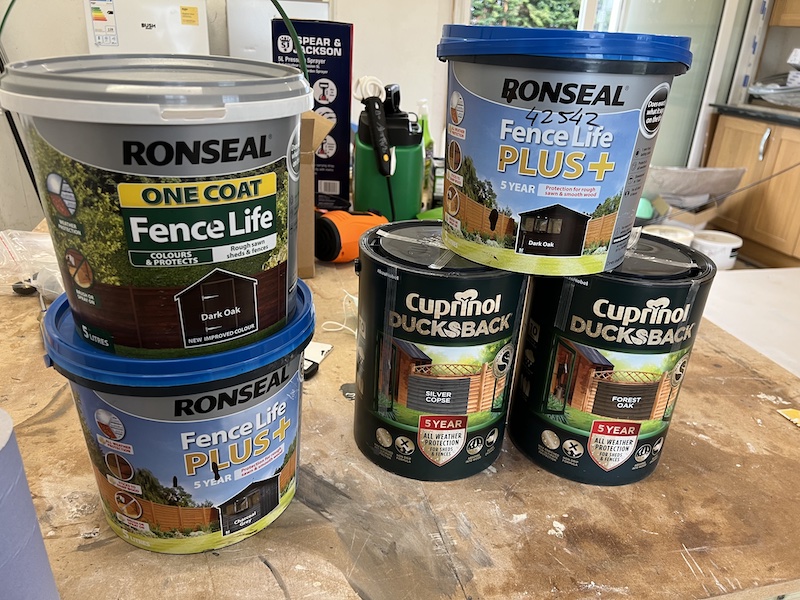
And what I discovered was a serious fence sprayer for not much money too along the way, as well as the best fence paint:
As far as I am aware, no one in the UK has pitted Cuprinol Ducksback vs Ronseal One Coat vs Ronseal Fence Life Plus Paint vs a commercial grade oil based creosote alternative called Creocote. I wish they had, it would have saved me some bother but the test results were astonishing and you’ll learn more in my few minute video ( I did and I thought I knew pretty much all there was to know about fence paint) than two days of split tests yourself 🙂
But I didn’t stop there, I used an old fence panel as well as new (they both absorb paint at completely different rates as I now understand from the fence paint testing experience). I wen’t even further than that testing application methods too (standard brush vs garden sprayer vs fence paint sprayer) but follow the link for a really interesting read and it’s worth watching the video too. If you don’t want to do that and just want the answers, here is the results of the testing:
Best fence paint top picks:
Best fence paint: Cuprinol Duckbacks 5 Year Waterproof For Fences [tested personally and proven] but I love the Ronseal Fence Life Plus Paint too. Especially these modern Grey’s that I’ve been testing. The timber grain comes through but look really contemporary!
Best value alternative to the Ducksback: Ronseal 5L One Coat best of the best for value by miles [tested personally and proven]
A close third: Johnstones Woodcare One Coat Shed & Fence Paint
Best oil based fence paint: Creocote wood fence treatment – beautifully enhances the wood appearance just like teak oil but for a fraction of the price. [tested personally and proven]
Best metal fence paint: Hammerite 5158235 Metal Paint
Widest range of colours: Johnstone’s 309290 Garden Colours
Commercial and heavy duty picks: Cuprinol and Creocote
Testing the best fence paints available in the UK
So paint has to be one of the most annoying products to pick, the UK is flooded with both quality and rubbish. When painting fences, it’s definitely no exception I can tell you from experience and testing. So what I decided was, enough is enough. I will test the best brands in the UK against each other once and for all, panels next to each other, side by side. So you can clearly see the results of each and compare them. But then I started thinking about new vs old fence panels (new absorb much more paint). Then that set me down the path of application. I thought, sprayers (both garden sprayers and electric fence paint sprayers) give a much more even paint coverage. So I decided to pit those against a traditional brush.
Testing fence paint conditions
So all of the fence paints tested required a temperature above 10 degrees. So I decided to pick a dry day above this. Cuprinol claim a 5m2 coverage per litre, Ronseal One Coat and their Fence Life Plus claim 6m2 and I know from experience Creocote goes miles further.
So the old panels I am testing are five foot. That gives you 2.74m2 surface area to cover. Now if you look, I’ve got a foot of trellis as well but for testing purposes I am going to ignore that!
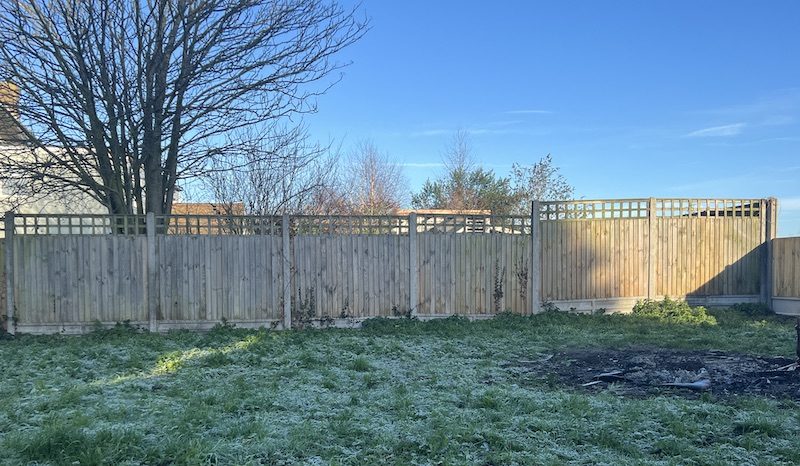
I decided a reasonable amount of paint, based on manufacturer guidelines is 800ml given both the standard Cuprinol and Ronseal says 2-3 layers. I appreciate Ronseals say 6m2 and Cuprinol 5m2, but I want it to be a straight up even fight. At two coats (5.5m2) the Cuprinol should just about make it. I don’t want this to be easy, for them! Not after I gave them such a stunning review in the shed paint article 😀
Don’t worry – I do realise one of the Ronseals is one coat but I want it to be a completely fair test and I have recorded the results after the first coat of fence paint and after the second coat too so you can judge for yourself if it needs an extra coat 🙂
For the new panels which are four foot, I also decided on 800ml. We both know untreated timber will absorb far more paint and I want this to be a realistic and sensible test so giving them every opportunity.
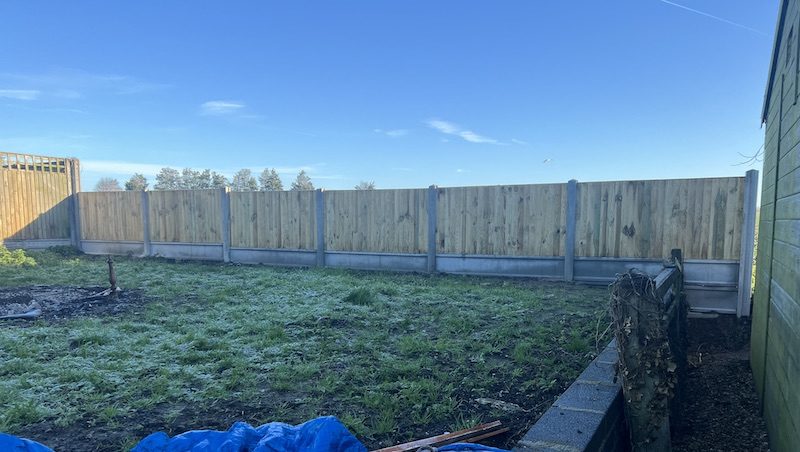
Don’t worry, I recorded the results every coat anyway as I already mentioned 🙂 so the test is essentially 400ml and 800ml per panel when broken down!
In terms of time between coats, I am supposed to leave it four hours, but since I want you to see just how good (or bad) one coat looks, I am giving it a whole night to set. It’s a far better test and from the benefit of previous experience, I know the Ducksback looks far more vibrant than it actually is after 4 hours 🙂
Fence paint application
I decided the only real fair way to test this was using a sprayer. The Cuprinol isn’t ideal for a sprayer as it’s too thick, so needs to be watered down to 2 to 1 . I know this from my shed paint testing of Cuprinol and what I read online. It’s fine to do so as the paint is water based anyway. However after using the Wagner fence sprayer I started using the Cuprinol without watering down as it’s capable. Handy tip that!
So this means with four different fence paints on test, and with sprayer used as a comparable as well. And then we are testing old and new panels. I am TESTING 8 PANELS total!! How glad to have the Wagner fence sprayer 😀
What paints did I test and why: Cuprinol vs Ronseal One Coat vs Ronseal Life Plus vs Creocote
I basically chose the very best paints and treatments available for fences available in the UK.

For the fence paints, I decided to go with Cuprinol Silver Copse and for the Ronseal Fence Life Plus, I chose Charcoal Grey. Now I’m colour blind 😀 but they look pretty similar. In the shed paint reviews I chose more traditional colours. For the Ronseal one coat, I couldn’t pick a modern colour as they are only traditional. So I’ve gone with Dark Oak. And of course Creocote is available as light and dark – given I am using Ronseal One Coat Dark Oak, I wen’t for the Light Brown Creocote. I went with the Silver Cuprinol as my sister had great results with this and still looks good 18 months on!
I decided to use Charcoal Grey from Ronseal in these tests when compared to the colours on the shed paint tests as I wanted to cover more aesthetics for you – it came out pretty nice at my sisters too. You can see the difference in aesthetics of Cuprinol Ducksback and Ronseal Fence Life Plus here.
Results after the first coat
Well the first coat was rather interesting. I won’t talk about ease of application and was it non drip here, but you can follow the link for that. I have to say, Ronseal one coat is definitely ahead of the curve on this one (probably pretty obviously). However, I feel the test a little unfair as the Wagner fence sprayer performed miles better.
A look at the sprayed on results directly after giving it a night to dry – Here’s the Ronseal one coat first which is thick and full:
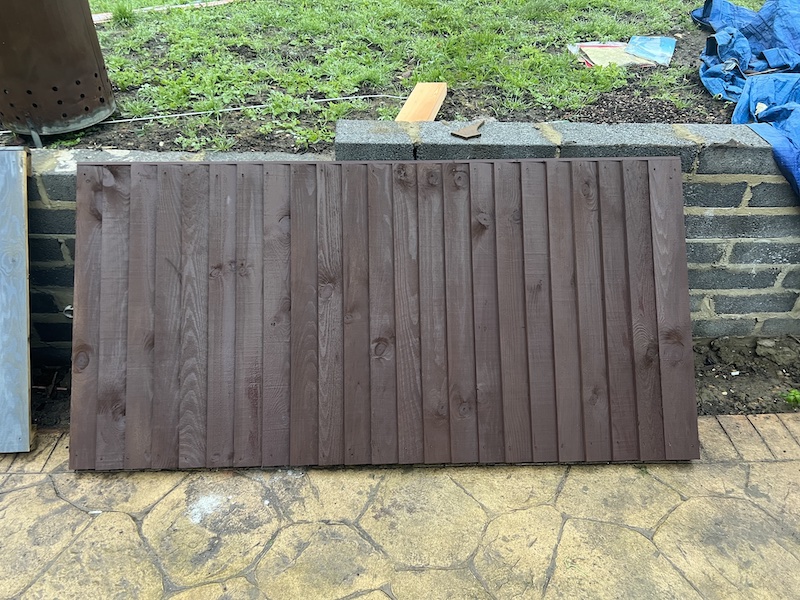
And here’s a look at the Cuprinol – now it’s wishy washy and patchy. I have to say I blame the sprayer more – I struggled a bit with the Ginour, especially when you look at how full the second coat is applied with the Wagner instead in the picture after the one below:
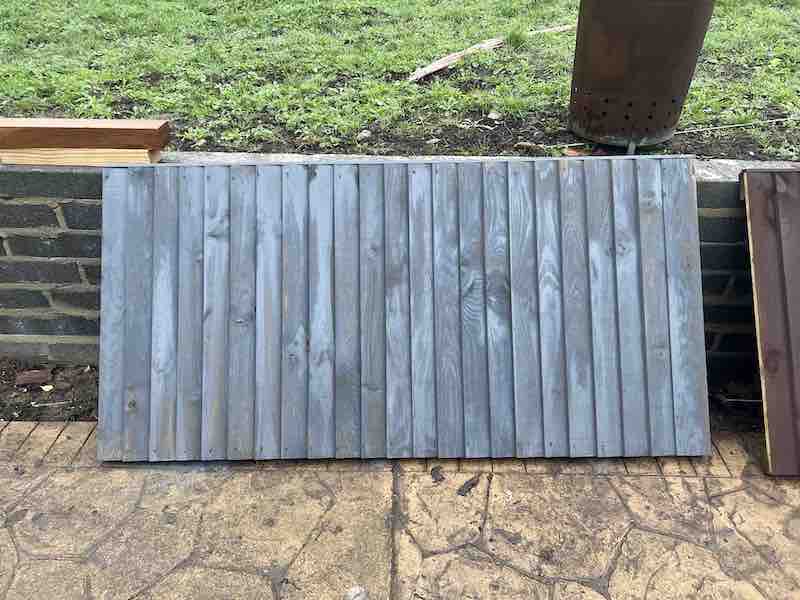
The Vonhaus sprayer was responsible for the Ronseal life plus. I have to say it was lighter to use but still no where near as comfortable as the Wagner. Again to an extent I’d ask you to look at the second coat application in the video to be sure. Here’s after the first coat though:
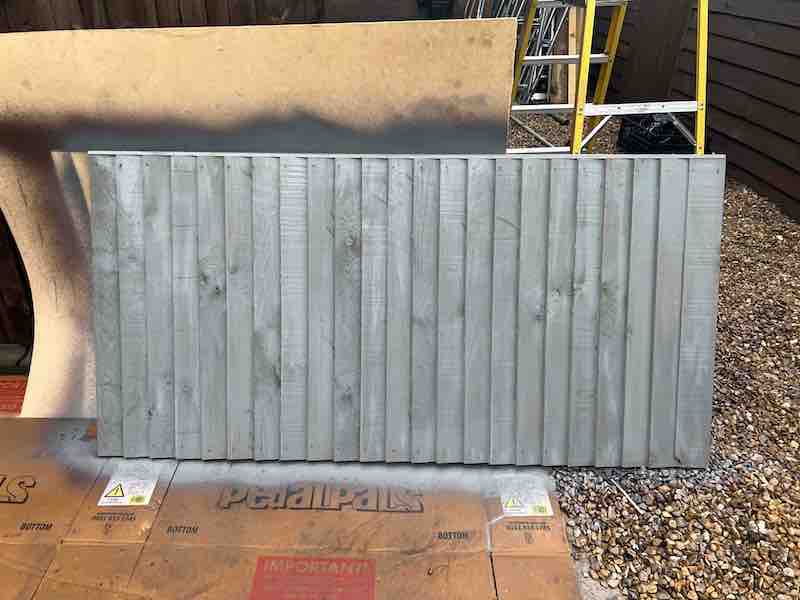
As you can see both the paints that stipulate the need for two coats are far patchier. the Ronseal one coat, in combination with the Wagner produced superb results, it really doesn’t need a second coat at all so I think I’ll cut the experiment short on that and definitely call the Ronseal one coat best budget and value for money with regards to the quality products available in the UK. Onto the second coat for Life plus and Ducksback:
Results after the second coat
Now obviously the One Coat from Ronseal didn’t need the second coat, but the Ronseal life plus and Cuprinol certainly did. Let’s take a look at what’s happened.
Here’s a look with the Wagner putting on a second coat with the Ronseal – it’s a totally different ball game and looking spot on:
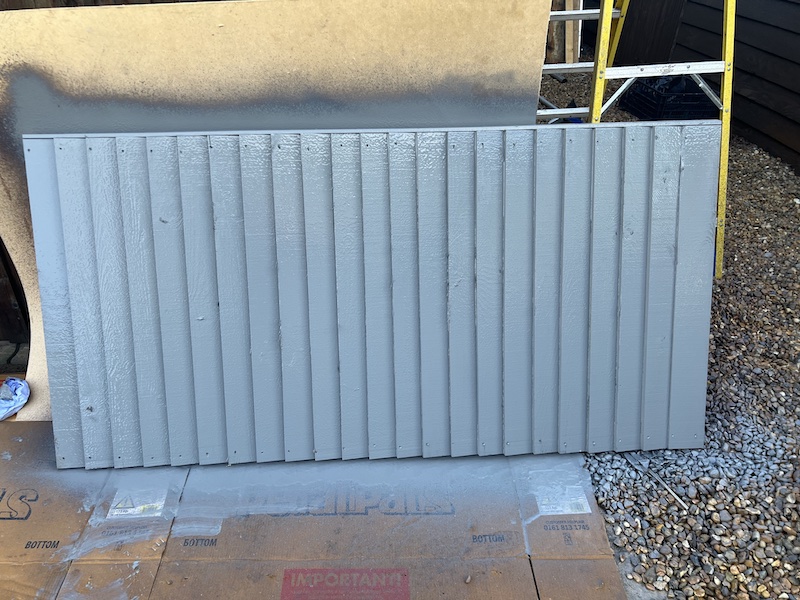
The Wagner was so impressive I turned down the power of the spray for the Ronseal – this also looks totally full and lovely in colour:
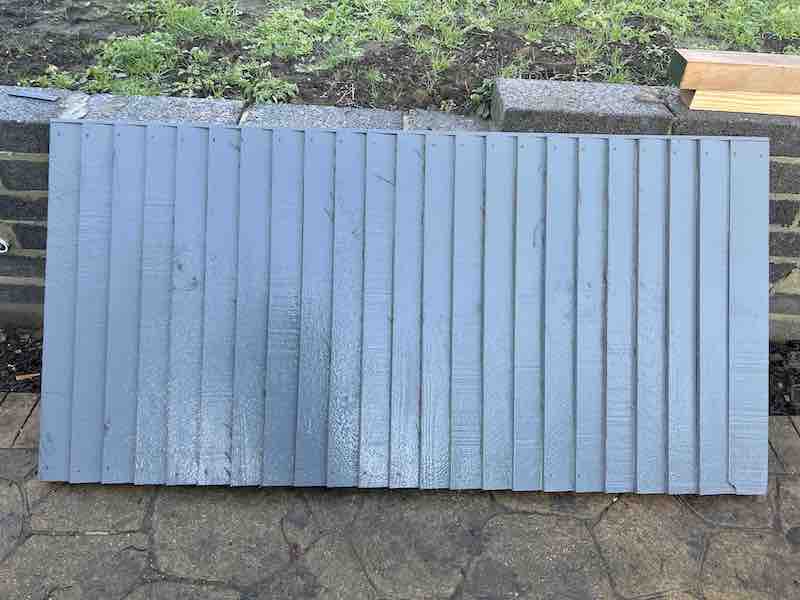
And here’s a look at Cuprinol dried up looking lovely:
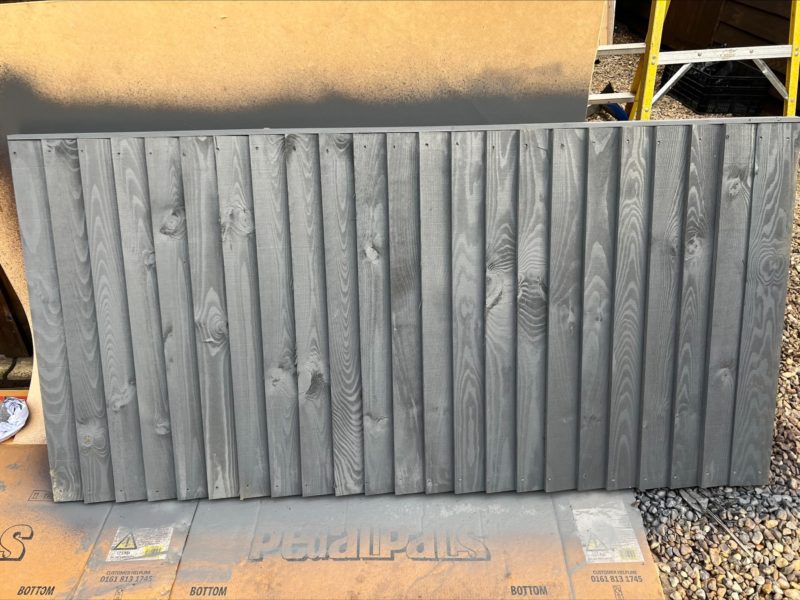
Here’s the Ronseal:
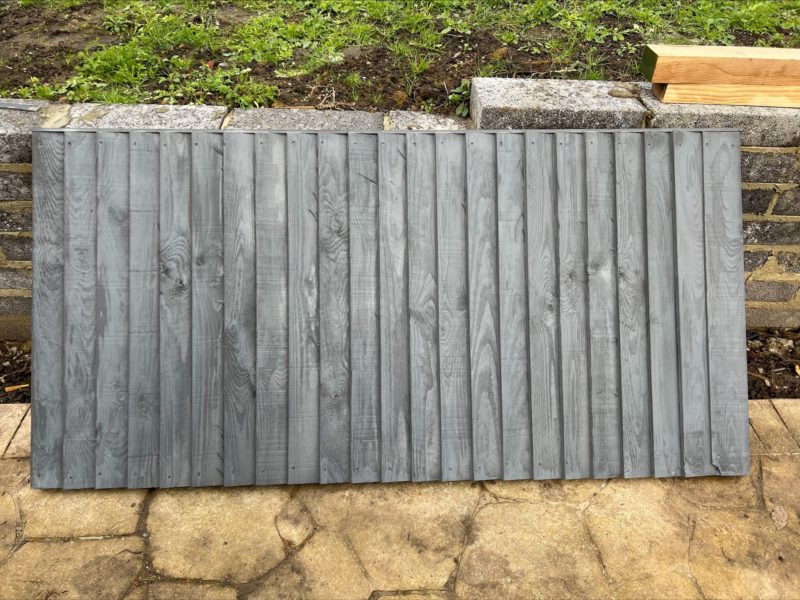
What do you reckon? Not much in it?
Non drip – how easy to apply?
Sure enough, the mighty Ducksback, was the winner. To be honest I knew this from the shed paint review anyway. The stuff is like tar out of the jar when you compare it to both Ronseal products. And obviously the Creocote isn’t far off water consistency so you’ll need to accept that’s a messy job or use a brush, and even then it’s still messy.
That is probably better seen in the video when I decant and measure out the paint for my shed. Check out this time. To see the difference more clearly. I must say it’s so thick I couldn’t even put the Ronseal or Cuprinol in the pot without spilling it using a ladle, that was about the only thing that really annoyed me.
Creocote is an absolute nightmare with a brush, I only kept going because of the test. I wouldn’t touch this stuff again without a garden sprayer or fence sprayer. I think a garden sprayer is enough this is pretty nasty and definitely wear a proper mask or you’ll feel sick after – that I sadly know from experience.
Which as the most water resistant/repellant?
Creocote is a professional, commercial grade product. There is no doubt about that and it comes with a ridiculous advantage over the other three in the test. It is oil based. If you’ve ever put oil in a jar with water and watch it separate you’ll understand what I mean, that or you’ve used decking oil or teak oil before (some the same). You’ll see the water droplets form on the surface and cascade away.
What makes the Cuprinol and Ronseal sensible though, is the waxy pigment. Wax is also superb about water repellant.
Fence paint modern aesthetics: Cuprinol Silver Copse vs Ronseal Fence Life Plus Charcoal Grey
To be honest, I am no expert with colours, my concern here is more with coverage but you can tell me what you think.


Traditional fence paint aesthetics: Creocote vs Ronseal One Coat Dark Oak
Now this comparison is far more interesting than the split of the modern as these are wildly different. I much much prefer Creocote and how it drags out the grain and natural timber qualities. This of course is a personal preference.
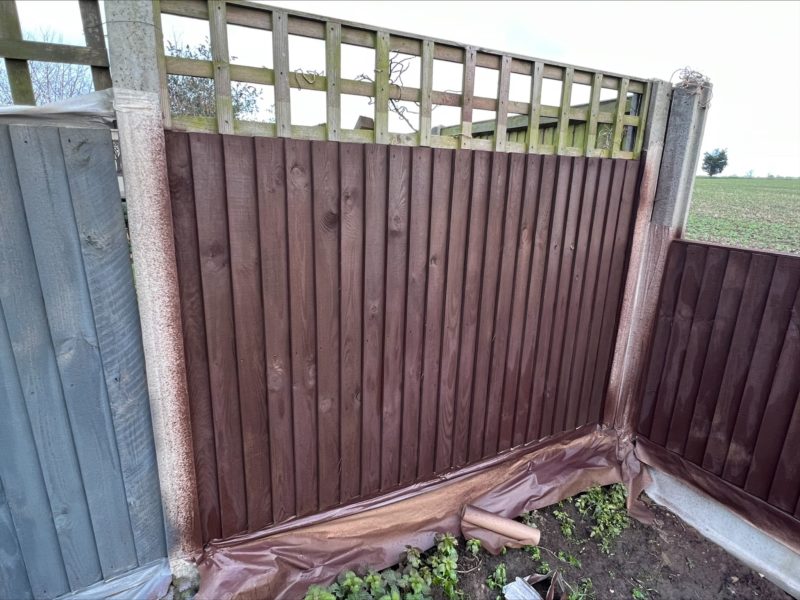
What else I tested
Have you ever used rubbish fence paint? I must confess I haven’t because I always use the best fence paint, in this case Cuprinol Duckbacks 5 year waterproof For sheds and fences. How didd I learn this lesson? Buying cheap rubbish emulsion from no naming names but it rhymes with ‘Twix’ some years ago in my youth thinking I could get a bargain. After rolling on about 5 coats and still seeing patches, losing a whole day, I finally cottoned on! In some respects that was a very good lesson to learn early on. I implore you to learn from this sound advice, but if you don’t, I guarantee you’ll remember this little anecdote 🙂
Best fence Paints Buyers’ Guide
After the extensive testing of Cuprinol, Ronseal, and Creocote I learned a few things that will save you a total melt down. Sound dramatic? Take a look at this disaster 😀
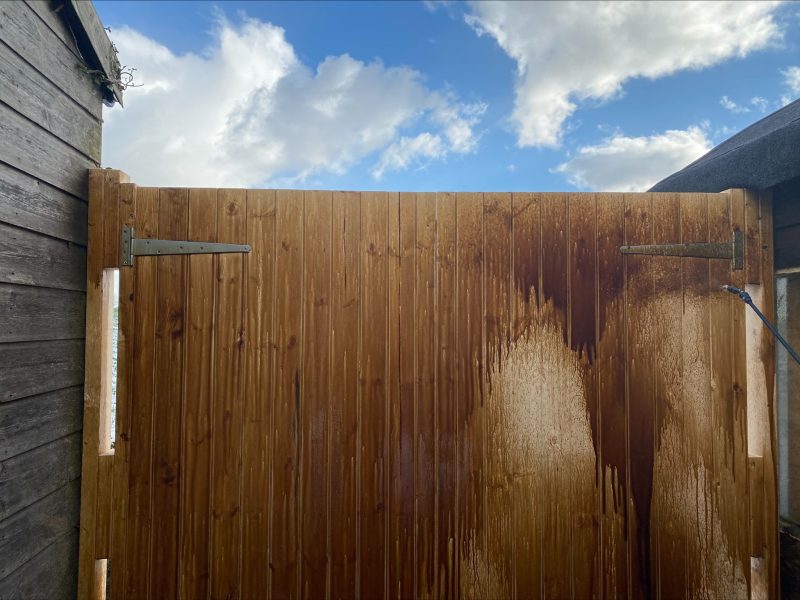
Yep some fence paints are seriously not non-drip and not designed for smooth timber at all. Luckily that was gravel and not a problem for staining. Imagine I had amazing Indian Sandstone or similar 😀 No amount of protective sheeting would have saved me in time! Don’t worry, in the buyers guide here I am going to run you through all the potential problems you’ll face!
‘One coat’ paints pros and cons
A few of the top brands now have products that are labelled as ‘one coat’ or similar, and it is very tempting, if only for the time saving aspect of it. From my experience, these paints really do only require a single coat and look great, at least the more well-known brands do – on the testing the Ronseal One Coat Fence Paint covered superb. On the other side of the coin, they don’t last as long as the new products like Cuprinol Ducksback and Ronseals fence life plus, before needing another coat. But since you only applied one to start with, it sort of balances itself out. Theres certainly a good argument for using a one coat fence paint.
Is it non drip?
Non-drip fence paints are just what they sound like, and of course, that is a good thing. You’d be surprised how much paint can be wasted, well maybe not from my picture with the Creocote above 😀 So if you’re thinking of buying a cheaper paint that isn’t non-drip to save money, you might end up actually paying more, as half of it will end up on the floor, your shoes, and everywhere else you can think of. I have proven this through testing clear as day, you need to make sure that smooth wood in particular, you use the right paint!
Buy a quick drying paint
The weather can change so quickly in the UK, and most often it is not for the better, so having a fence paint that can be both dry and rainproof in the shortest time possible, is a must. Single coat paints tend to be thicker and dry a little slower, but the best ones are still showerproof within a couple of hours. Paints like Ronseal’s Fence life extra are even faster, and will be good to fight off the rain in about an hour. They still need four hours between coats though and that applies to Ronseal, Cuprinol, and Johnstones.
So, there you have it, a few things to look for in the best fence paints, and a selection of or honest reviews on the best of the bunch, Hopefully we have helped you make the right decision for your own fence painting needs, and would like to invite you to check out some of our other related pages such as best paint sprayers, best paint brushes, and best paint rollers.
Best fence paint
The best fence paint will apply easily with a roller, fence sprayer, or masonry brush. It should leave a full looking paint finish with minimal coats, protect wood for many years, ideally not smell too much on application, and be sensibly priced. That’s how I’ve picked your top best fence paint and if you want more detail the best fence paint buyer’s guide will help understanding the differences in products and their qualities too.
1. Cuprinol Duckbacks 5 Year Waterproof For Sheds And Fences, 5L
the best fence paint without question; Cuprinol Ducksback, is more than worthy of the top on our best fence paints list, and another I have personally used today with good results and it covers superb in a couple of goes. it doesn’t matter what Curprinol are making, they just want to be the best. They’ve been the best literally for so many years I cannot remember. The Cuprinol 5 Star rot treatment and wood preservative was nothing short of incredible in it’s time.
This is a great fence paint to use for waterproofing purposes as it has been enriched with wax, and this just brings it to the next level of rain resistance. What’s more, just like with Ronseal’s best products, this one is showerproof after an hour or so. Here’s a look at my most recent before and after tests:

Then I switched up to the Wagner sprayer and things dramatically improved on the second coat:

Once set it looked absolutely superb – after using my fences to test various colours I will be settling on this – don’t panic until it’s set, below is the result you’ll get from two coats with the Wagner sprayer:

Available in four different colours, and each one looking fantastic, a 5-litre can should give you enough paint for about five 6x5ft fence panels if you’re giving them a double coating, and I recommend that you do, especially if you want the paint to last for years to come. I know the advertising claims you can do 10 panels of that size, but that would be with a single coat and I do think bare timber (or timber previously a different colour) needs two, take a look at a couple of examples here from earlier today covering new timber (in the video) and an old gate:
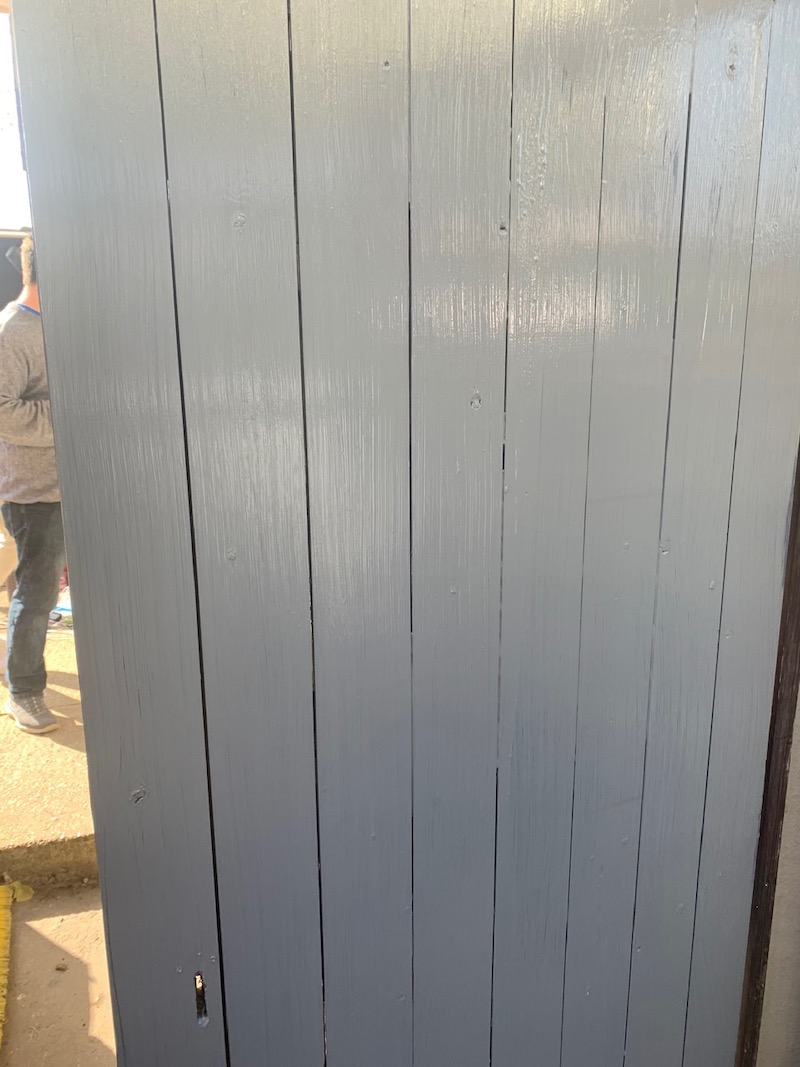
This stuff is a dream to put on with a brush, and it really does live up to the ‘non-drip’ claims of Cuprinol, and my best ‘painting wellies’ didn’t look too worse for wear after the job was done. Here’s a quick example video if you’re on mobile using the Cuprinol Duckbacks 5 Year Waterproof For Sheds And Fences, forgive my sister she does take her time and doesn’t like to lay it on thick 😀
It’s not too thick making it the best fence paint for spraying. You know, I try to find fault with Cuprinol to bring balance but they are miles ahead. Feel free to buy my Ronseal second pick which is ahead of the rest and it is still miles behind Cuprinol 🙂 then you’ll see for yourself, sadly the rest of my Ronseal is going in the bottom of the shed until I can find some obscure project for it or I run out of Cuprinol.
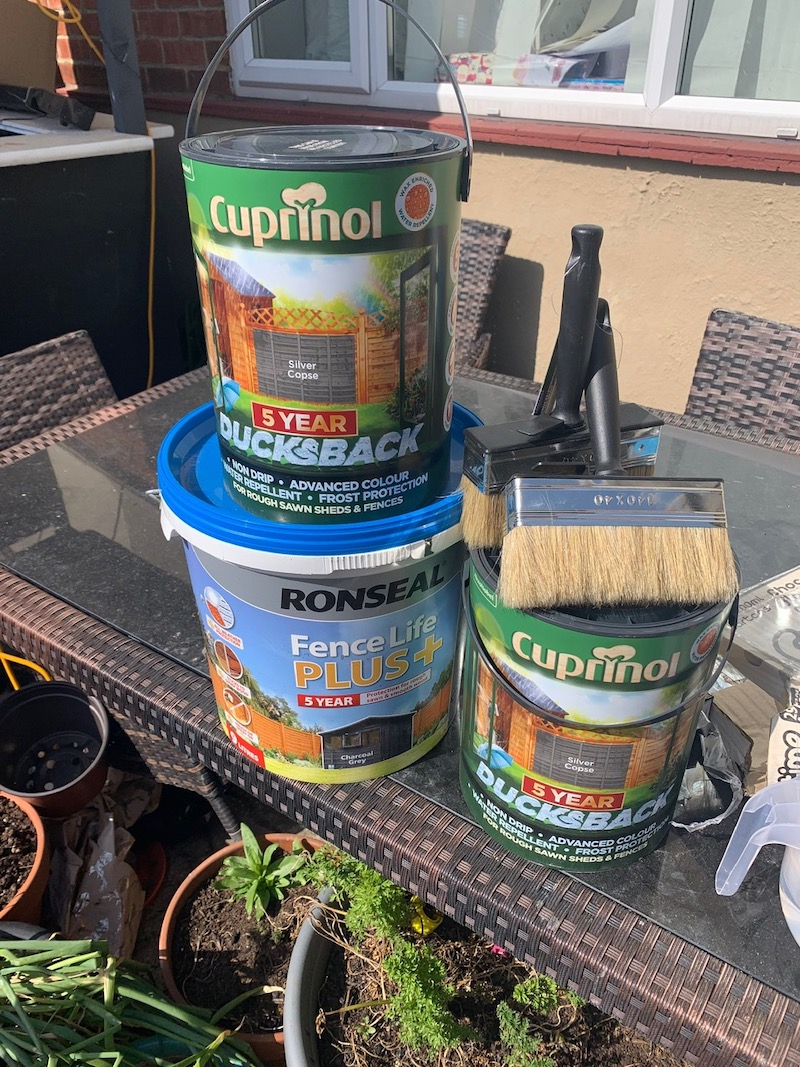
Many out there swear by Ronseal, as I do about the Ronseal two part filler which is without doubt the best wood filler in the UK. It’s just on this occasion they are completely outgunned.
Some fence paints have a very strong odour and this can leave to headaches and nausea after using them for a while, but with Cuprinol Ducksback fence paint, there was none of that, and that is just another reason why this product is worth the money
2. Ronseal RSLFLPPCF5L 5 Litre Fence Life Plus Paint
Ronseal have made a very good name for themselves over the years by continually producing innovative new paint products and stains onto the market. I was already a big fan of their fence life one coat paint after using it for my very own garden fence, so I was excited to try out their latest stuff: Ronseal fence Life Plus. I will admit, I wasn’t expecting the same performance as Cuprinol but it was right up there, though I was worried on the first coat just like Cuprinol:

The second coat looked much fuller and far happier but it changes completely once dried, let’s have a look at directly after I’ve laid on the second coat first:

Now once it’s set I think it just looks lovely too. Very modern and contemporary but I have to say I did still prefer Ducksback. That’s a personal thing though, this is looking protecting wood just as it should too:

I just feel like the grain came out more on the Cuprinol and looked pretty dramatic. What do you think? This is totally a personal preference thing
Touted as their most advanced paint to date, it has been formulated to give protection against all the usual winter threats like rain, snow, frost, and also to fight off the negative effects of UV when the weather gets better. This makes it perfect for places that have an unpredictable climate, and so it is a sure winner in the UK. I have to say after the last few days of cold I can say with experience and testing certainty that minus temperatures are no problem at all.
It’s quite versatile in the way it can be diluted and then applied to any fence or wooden shed using a paint sprayer, or used as-is with a brush for doing the finer final touches round the edges.
The speed at which this fence paint dries is impressive, and it is said to be showerproof after just an hour. The weather was good on the day we were testing the product, but we gave it a light sprinkling with the garden hose to see if the claims were true, and I’m very happy to report that they were.
Priced at around 20 pounds for 5 litres (Covid price raises I’m afraid), it is slightly more expensive than their ‘One Coat’ product and I will say it’s not quite as good when I put them head to head today as the Cuprinol.
3. Bartoline Creocote Creosote Substitute Dark Brown Timber Wood Fence Treatment
I’m not going to go through Creocote entirely as I covered it in the shed paint section as well as the fence paint testing here. As you can see from the pictures, the colour of the wood is enhanced beautifully, and water really beads and drips off lovely. What is more, from testing I found it goes much further than Cuprinol and Ronseals two different paints. Here’s a look at the fence panels before and after painting:
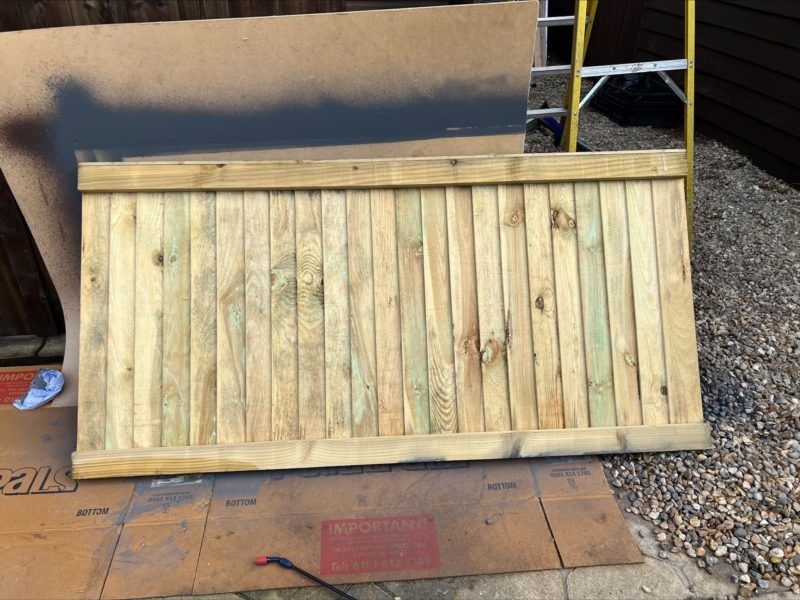
And here’s a look five minutes after – I just sprayed it on with a garden sprayer (my favourite the Spear and Jackson):
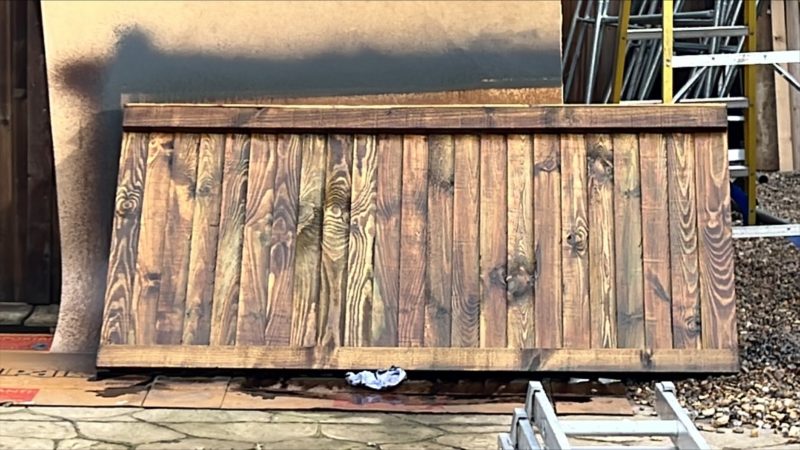
Now it’ll calm down like my shed and leave a really nice sheen in a few weeks time – I have literally just painted this on so if you view this in a few weeks from that date I will have a picture for you of how this calms down like the shed paint creocote article. UPDATE: here’s a look now it’s calmed down:
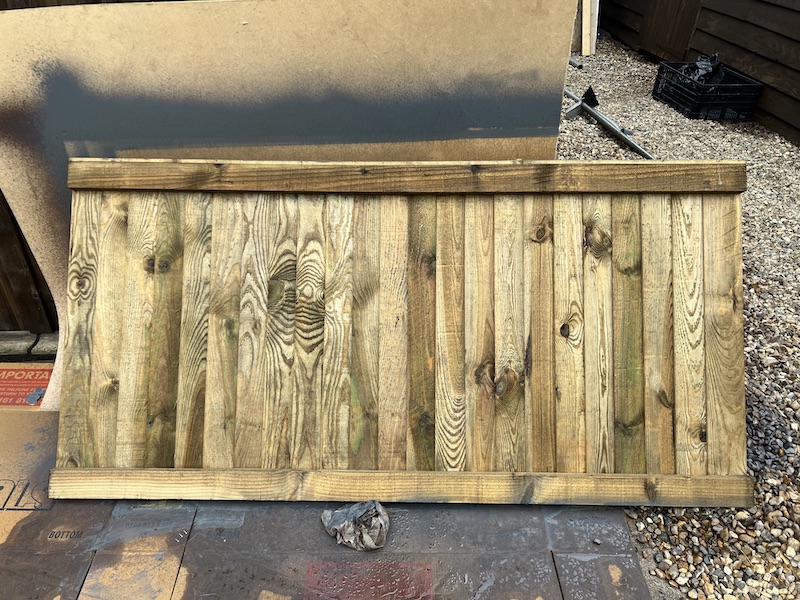
Here’s a look in the video:
In fact it’s worth taking a look there as if you have existing painted timber you will see I use a petrol pressure washer to blast that down and fully prep everything in order to leave a beautiful finish, and it really is. New timber like this just comes up lovely off the bat and it really highlights the grain lovely – remember you can get a lighter Creocote if you follow my link too which obviously doesn’t finish quite so dark!
What a vast improvement. If you appreciate wood like I do, you really will appreciate just how well this enhances the grain and really draws it out with a deeper, shinier look. And it isn’t too shiny either like varnish in my opinion. The closest comparable is teak oil.
If you’re looking for heavy duty commercial grade then it has to be Creocote – it’s the only shed paint come treatment left in the entire range that is oil based. And if you know anything about oil based paints for external joinery, you know exactly why I rate this so highly for longevity.
In terms of application this is pretty much covered already in the test – but very quickly, I found this applies best with a traditional garden sprayer. No need for the electric paint sprayer unless you want the job done even quicker! Do I think it’s as good as Creosote? No, but then Creosote is now banned in the UK for domestic use and is illegal. Thanks EU Decision makers!
Overall it’s hard for me to ignore this, especially after the incredible job it made of painting my shed too. It’s pretty much perfect for any rough wood in the garden. And that’s probably it’s only fail point. DO NOT TRY TO USE THIS ON SMOOTH TIMBER – 😂 here’s a look at my total test fail:
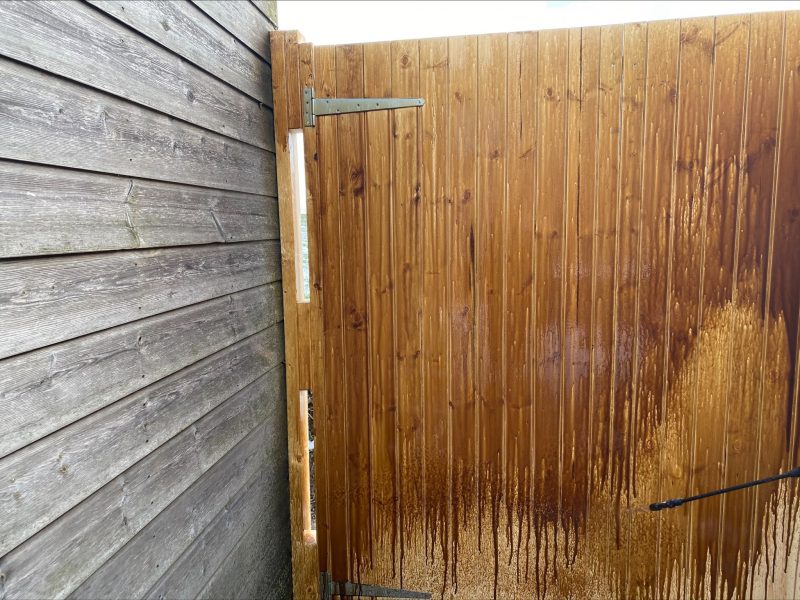
It was so good on the shed I thought I’d paint the fence gate too. Nope. Total fail 😀 It reminds me – do not get this on anything that won’t clean up – it stains badly. Top tip that.
Apart from that, this has been superb and lasted 18 months on the shed already and looks as good as new mainly because it’s oil based and bites in deep – easily the best actual protection other than wood preservers for fence panels in the UK at sensible money!
4. Ronseal 5L One Coat Life
My original, favourite, fence paint, Ronseal’s One Coat product is still right up there with the best of them in my opinion. The reason I like it so much is, to quote the famous advert: it does exactly what it says on the tin. Yes, it really only does require a single coat of this stuff to transform your tired looking fence into something to be proud of – sounds like an advert doesn’t it? Well you should know me better than that I am brutal when a product isn’t up to scratch! Here’s a look at that one coat finish:

It is very easy to apply by sprayer, brush, or roller, and due to its thickness, there is very little dripping or splattering, unless you paint like an enraged toddler, that is 😀 When spraying obviously watch the overspray if near anything you don’t want to coat and here’s a look at that video of how well this sprays with a Wagner incase you didn’t watch above:
In just over two hours, this fence paint will be dry and able to withstand the rain, but it hasn’t got the same formula as the newer Ronseal fence life plus to protect it from frost and UV. Haven’t said that, it does protect your wood from greying.
While a lot of new products are claiming to last for 4-5 years, Ronseal are a bit more conservative when it comes to this stuff, and say it will keep its colour for 2 years. When you consider that that is with only a single coat, it is still very impressive. So what I did was decided to lay a coat on a panel that’s already got some stain on it. I have to say the results were impressive again:
Here’s a picture before:
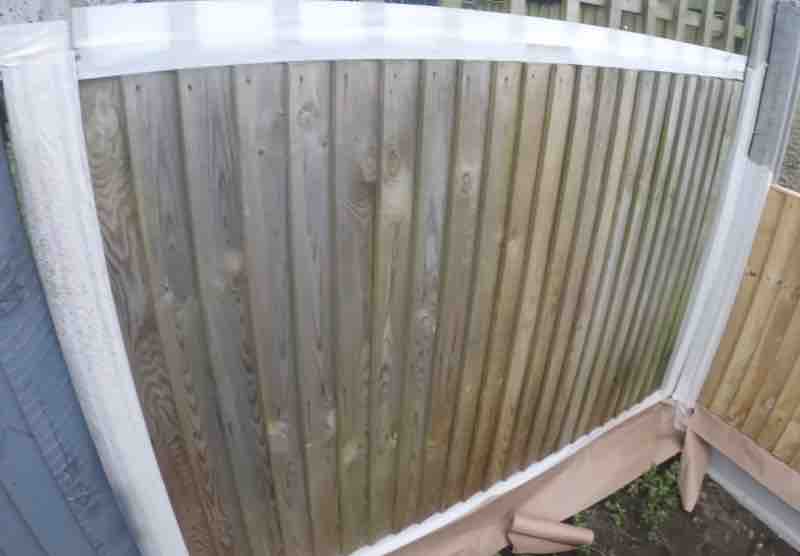
And here’s a look at that after one coat:

It’s available in a good selection of natural looking colours, and giving an opaque. Matt finish, that looks the business, this is perfect for fences and sheds that need sprucing up, and for people who might be a bit short on time to do the job. With only one coat needed, it certainly speeds up the process.
5. Johnstone's 309290 Garden Colours
Johnstone’s Garden Colours fence paint really lives up to its name, offering you a wide range of shades to choose from. In fact, there are a total of 18 different colours, so it shouldn’t be too hard to find something that tickles your fancy. While not quite as quick drying as Ronseal and Cuprinol’s products, this is still no slouch and only takes a couple of hours or so for it to be showerproof.
We tested Johnstone’s paradise petals colour as we were painting a Wendy house for a friend’s daughter. After two coats the paint looked amazing, thick, and the colour was so vibrant, so this would be a product I’d recommend if you’re into brighter colours. It really bonds well and filled the gaps. The problem I have is it’s almost impossible for me to pick over Cuprinol, knowing how it’s already time proven.
On the plus side, being a water based paint with a wax addictive, this is a plant and animal friendly paint once dried, which is good to know for a keen gardener such as myself who likes to do all he can to keep his botanical babies looking their best.
Johnstone’s claim that this paint will last for four years, and I’ve no reason to doubt that based on our time working with it. As already stated, the finished product was thick and even had a waxy quality to it on the wood when it had dried completely. I think, to get the full four years’ worth out of this paint though, you would need at least two, maybe even three coats, so make sure you buy enough to cover that. Overall it’s a decent option if you’re not feeling the major brands Cuprinol and Ronseal.
6. Johnstones Woodcare One Coat Shed & Fence Paint
Another fantastic product from Johnstone’s, this one coat shed & fence paint is definitely up there with the best on offer, but does it live up to it’s ‘one coat’ name like Ronseal’s offering?
After our time testing it, I have to say that it does. We painted on a single coat of their Golden Chestnut paint onto a new, rough, wood fence and the results were excellent. The paint is very thick and has a nice matt finish.
However, there were moments at first when I was a bit worried, as Johnstone’s paints look quite a different shade when you first apply them to when they are fully dried. This is true for most fence paints, but I’ve noticed that this is particularly true with Johnstone’s products, so please don’t be alarmed at first and give it time to dry. You’ll be happy in the end, trust me.
The paint dried in about 2 hours, which isn’t bad considering the thickness of it, and although way too early to tell, I would put good money on it lasting the three years that are claimed by the company.
Wax enriched, it provides a really good level of water resistance, making it ideal for not just fences but sheds, wendy houses, tree houses, and wooden garden furniture too. We gave it our hosepipe test, and was happy to see the water simply bead up and run off the surface.
Even though Covid-19 and supply problems have increased the price of most products these days, I still don’t think that the current price for a 9 lite can is that bad at all, and it should easily cover a single coat on an entire fence of average proportions.
7. Hammerite 5158235 Metal Paint
Not all fences are made of wood, and while you can certainly use any of the products featured here today on your metal fence, my advice would be to go for a fence paint that is specifically made for that purpose.
Hammerite is a well-known and trusted name (in fact I can still hear the song ‘any old iron…’ from their advertisements back in the early 90s!), so it should come as no surprise that their product is the one we picked for best metal fence paint.
Easy to apply via sprayer, roller, or brush, Hammerite’s metal paint can even be applied onto rust, and has an anti-corrosive pigment in the formula, designed to react with moisture in the atmosphere and create a protective barrier for your fence.
There is no need to have multiple products to make your metal fence look as good as new, as this one does it all, and can act as a primer, undercoat, and topcoat, and the results are outstanding, leaving you with a wonderful shiny, gloss finish.
Now, I do have to tell you that this stuff is thick, and quite sticky, so invest in a pair of gloves that will give you good protection and dexterity, or you’ll end up spending longer trying to scrub this off your skin than you did painting the fence.
With a decent pair of gloves though, you will soon have that rusty old chink of metal outside your house looking like Buckingham Palace gates, minus the guards in funny hats, of course.
FAQ for fence paint from my personal testing:
I’m often asked questions that are relevant to so many that I’ve decided I would start an FAQ on this page based on my testing. This will entail basic questions all the way up to small differences between colours between the major leading brands. Here’s some of the the best questions I’ve had so far:
Colour difference between Cuprinol Ducksback Forest Oak vs Ronseal Fencelife Plus+ Dark Oak
Question:
Just read your very interesting article about fence paints online
I’ve always used Cuprinol Ducksback. However, after moving recently, I have lots of fencing which has been untreated for many years and some fencing which has been treated previously with a dark brown colour. Decided to continue with the dark brown colour for consistency and use for all the untreated fencing and the 3 x garden sheds close to the fencing.
For some reason I must have been looking at the incorrect chart and I did not think that Cuprinol had a dark brown shade in Ducksback. I therefore purchased Ronseal FenceLife Plus+ ‘Dark Oak’ colour and have used that, two coats for many of the panels and will obviously continue with that for the remaining panels. Have already used 25 litres! It looks fine and it’ll be interesting to see what it looks like after the 5 years stated on their tin.
The Ronseal Fencelife Plus+ is good but personally I still do prefer Cuprinol Ducksback in terms of water run off and the non drip consistency. I now realise that in the Ducksback for fencing Cuprinol do manufacture a dark brown colour, called ‘Forest Oak’ which would have been as perfect a colour as the Ronseal that I have used.
So, here it is: My question is, and you may know the answer to this with all the stains and colours you have tested:
Q: If I now painted my 3 sheds which are all close to the fencing with Cuprinol Ducksback ‘Forest Oak’ colour would it match extremely closely or exactly or not worth the risk or not a colour match at all to the Ronseal ‘Dark Oak’ colour ???
I already have 2 part used tins of stain from years ago left over from errors in colour choices !!
Look forward to hearing from your and your advice
Answer from testing
It’s a great question. I ran a direct test earlier this year and have the very picture on camera from this using one coat only. Please note that the left hand side is the Cuprinol Ducksback Forest Oak and had to be diluted as it wouldn’t go through the sprayer. The right hand side is the Ronseal Fencelife Plus+ Dark Oak. Here is a look at that:
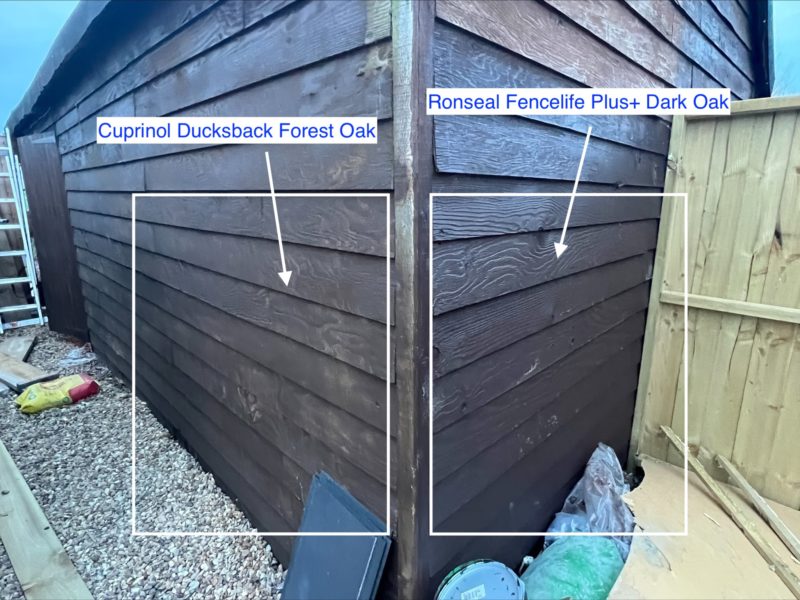
As you can see (and I’m colour blind) – it is pretty apparent to me that the Cuprinol Ducksback Forest Oak is lighter than the Ronseal Fencelife Plus+ Dark Oak – this is an on the ground test and they both had the same base colour to start with – even with another coat of Cuprinol Ducksback Forest Oak I don’t think you will achieve the same colour.
However with that all said, this is a shed at a different angle – they would both need to be in view to be obviously noticeable I think – I hope this helps.
Can I change my fence colour from red/brown to grey?
Question:
Wendy asked a fantastic question: Can I change my fence colour from a Red Cedar to Charcoal grey? Now it’s a great question and is essentially a dark colour cover up possible with a grey fence paint?
Answer after testing
When you paint walls indoors it always takes a fair few coats to cover dark colours. So, I was interested to know how many coats it would take myself and as chance had it my wife set about painting the fence with the kids – albeit the wrong colour it was simply to keep them occupied 🙂 Here’s a look at the dark brown where the kids painted the fence brown:

As you can see the kids didn’t quite finish painting the fence 😀 But what really surprised me was just how well one coat of Charcoal grey actually covered this fence. I mean it definitely has a slightly different darker look to a panel freshly painted with no dark colours behind it, but honestly, that’s only one coat, it’ll become far more grey on a second and third (which I will get around to at some point).
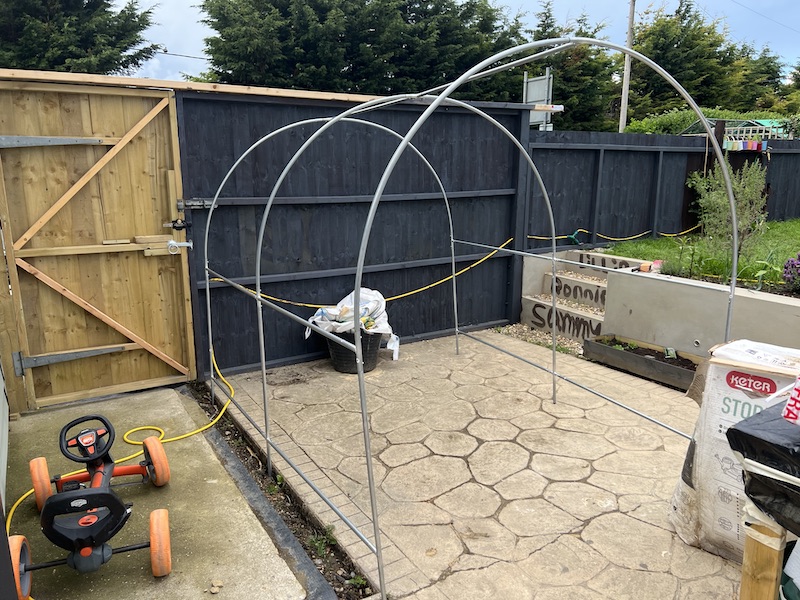
And to understand the slight different colour it’s produced, here is a look at a fence panel that was unpainted before using Cuprinol fest paint:
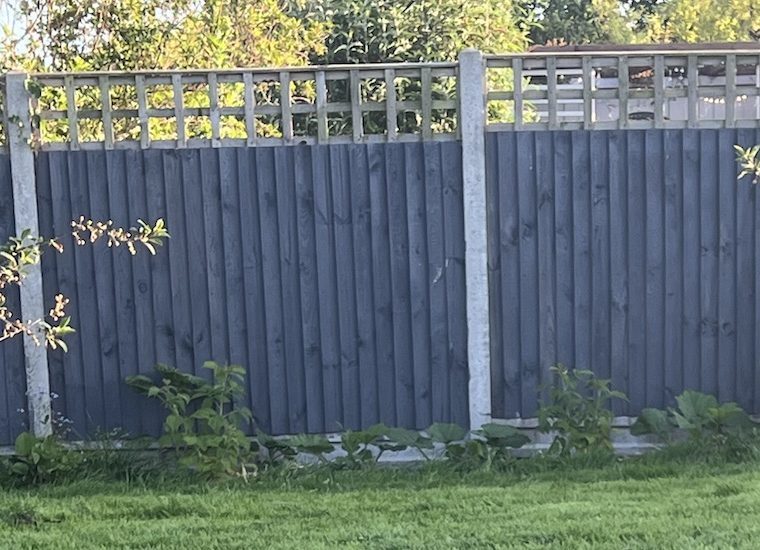
As you can see the results on one coat of paint are pretty decent – this was Cuprinol Silver Copse which is as close to the grey as you’ve asked about – the actual dark grey by name you refer to might be the Ronseal one coat which Ronseal charcoal grey would yield equally as impressive results and if you want to pay a few extra quid the Ronseal charcoal grey plus isn’t a bad shout either – in fact I find it to be the best value for money personally. Sadly no more kids faces but it answers your question perfectly.












Hi Terry,
Could you explain the difference between the two different “second coat” Ducksback pictures as one looks like paint and the other is allowing the grain of the wood to show through? Is the first picture still wet paint? The second after its dried? Or is it old wood and new wood? I love the look of the wood grain so I am trying to work out how you got this.
Many thanks
Hi Andy,
Please send me the urls of the images you refer to thanks.
Hello Terry.
Are any of the any good on smooth timber fence slats?
Thanks.
Hi Paul,
On smooth timber I had decent results with both Ronseal fence life plus range and Cuprinol Ducksback despite the Cuprinol Ducksback I used not being recommended for planned finish timber. I’ve got tests showing two years later the Cuprinol standing up well on planned (smooth) timber. Hope this helps.
Regards
Terry
Thanks for the tests. I love Ducksback and used it in our previous garden on a mix of rough sawn wood and smooth wood. It was way better on the rough wood and I would only recommend it for use on rough wood as suggested on the tub. Have you used Cuprinol Garden Shades at all on smooth wood?
Hi Matt,
Yes, Ducksback, and in fact any of these do bind better to sawn timber – the better the key, the better the adherence – notice my test of creocote on planed timber 😀 Won’t be doing that again!
I have a friend who used this on his fence posts and fence panels. Whilst the panels were sawn timber – posts were smooth concrete, and I was surprised just how well the paint had bound to such a smooth surface. So my bet is yes it’ll stick, but a small test pot from Cuprinol direct is 125ml and used to be a pound from b and q, homebase etc. Worth a test in a small area to satisfy yourself first of how flat it lays down too. Hope this helps
Regards
Terry
Hi Terry,
I currently have my fence painted with Ronseal red cedar, but I want to change the colour of the fence to charcoal grey. Will the charcoal grey properly cover the red cedar with a couple of coats? Or will the red cedar still show through? Thank you.
Hi Wendy,
I did something similar myself and it’s a really good question so I’ve added it to the FAQ – you can see it here: Can I change my fence brown brown to grey?
Regards,
Terry